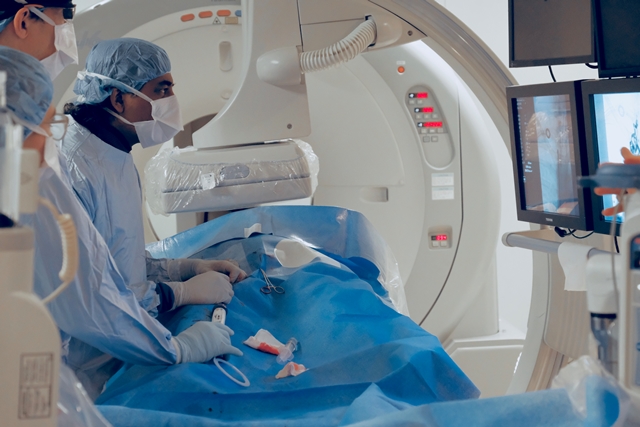
By Roger Boyle
Sometimes it takes looking at a situation differently to find simpler and safer approaches to patient care.
This is evident for the Joint Department of Medical Imaging’s (JDMI) Interventional Radiology Team, who earlier this month, made the University Health Network (UHN) the first centre in Canada to establish central venous access (CVA) using an Inside-Out Catheter System.
“Traditionally, when we try to get into veins we puncture from the outside-in – from the skin into the vein,” says JDMI’s Dr. Dheeraj Rajan, Lead Interventional Radiologist for the procedure. “This novel approach is actually coming from the inside of a blocked, inaccessible vein and puncturing out.
“It creates another option for patients which they didn’t have before.”
This new approach, meant for patients with chronically occluded or blocked veins, is an alternative to vascular bypass surgery, and used when all other procedures for central venous access have been exhausted.
It works by manually inserting a device through the femoral vein in a patient’s thigh and navigating it up past the heart, into the occluded venous segment. The device is then pushed through the occlusion internally, and a needle within the device is advanced out through the skin.
With the needle then providing a direct path through the occluded vein, a central venous access device can be inserted.
The Canadian-first procedure, performed in conjunction with Peter Munk Cardiac Centre Vascular Surgeon, Dr. George Oreopoulos, came about following multiple failed venous access attempts for UHN patient, Kira Whitehead, who, due to past surgical complications, has ongoing needs for intravenous fluids and medications.
“I’ve been through over 20 PICC lines, two ports, and two Hickman’s, all of which have failed at some point,” says Kira. “I have potential for a long life-span ahead, and not being able to access any of my upper veins is a serious concern.”
At just 43 years old, and having already dealt with a number of serious illnesses, including bowel obstruction, C. difficile and kidney failure, Kira was willing to explore every option available to her.
“Everyone’s there when you’re critically ill, and then they all sort of just disappear,” she says. “So for Dr. Rajan and Dr. Oreopoulos to undertake this, means a great deal to me.
“I’ve had a lot of promises, and very few people have meant what they promised to do.”
The procedure, performed with a special case-based approval from JDMI/UHN, was completed successfully on Oct. 4 at Toronto General Hospital, and Kira can now receive fluids and medications through a high-flow central venous port.
“It’s rare that patients get to this situation,” says Dr. Rajan. “We can usually open up blocked veins from the outside-in with traditional methods, but in Kira all of that failed – multiple times at multiple institutions.
“We want to extend her lifespan as long as possible and this gives us an option we didn’t have before.”
Roger Boyle is Communications Specialist at University Health Network.

